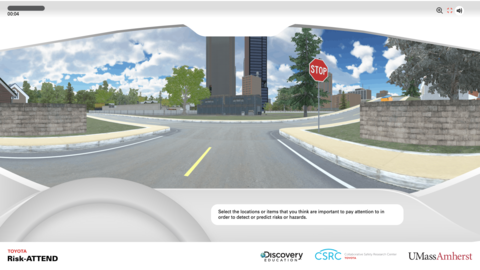UMass Amherst and Toyota Collaborate to Address Risk Anticipation Gaps in Drivers’ Ed
The fatal crash rate per mile driven is three times higher for 16-to-19-year-old drivers than it is for the 20-plus crowd. To help reverse this trend, Toyota’s Collaborative Safety Research Center (CSRC), the University of Massachusetts Amherst and Discovery Education created a course that teaches risk anticipation, a skill that often isn’t covered in drivers’ education. The course is now available here for new drivers to take for free online as part of Toyota TeenDrive365.
Risk anticipation is the ability to pick up on precursors to potential dangers. “The classic example is you’re driving down a residential street and a ball rolls out in front of [your] car,” says Anuj Pradhan, assistant professor of mechanical and industrial engineering at UMass Amherst and principal investigator on the research. An experienced driver knows that there’s a kid behind the ball, but new drivers don’t necessarily know this until they’ve experienced it, Pradhan explains. “Then they slam on the brakes and they learn from that. But why wait for exposure to such situations if we can accelerate that learning through training?”
That’s the key question behind this new learning module. Risk anticipation isn’t a part of current drivers’ education curricula. “It’s very involved to educate teen drivers,” says Pradhan. “There’s a lot to learn.” Drivers’ ed focuses on how a car works (turning it on, using a directional signal, what the different dials and levers do) and the essential rules of the road. “I have a lot of respect for drivers’ ed, but they don’t generally focus on higher-order skills.”
This project was focused on developing training for teen drivers… the skills that they don’t get when they’re undergoing drivers’ education & they learn over time. If they’re learning it over time, that means they’re learning on the road, so it’s risky.
Anuj Pradhan, assistant professor of mechanical and industrial engineering at UMass Amherst
“This project was focused on developing training for teen drivers to accelerate some of the skills that they don’t get when they’re undergoing drivers’ education and they learn over time,” he continues. “If they’re learning it over time, that means they’re learning on the road, so it’s risky.”
The new learning module, Risk Anticipation Training to Enhance Novice Driving (Risk-ATTEND), tries to mitigate some of the most common ways that teens crash, which are intersections, rear-end situations and run-off-the-road scenarios.
“We ask students, ‘when you look at this environment, where do you think a hazard might appear?’” explains Shannon Roberts, associate professor of mechanical and industrial engineering at UMass Amherst and co-PI on the research. Some of the scenarios in the training include mid-block crosswalks where there is no traffic light or stop sign, left-hand turns and cars or pedestrians obscured from view by trees or busses.
Risk-ATTEND is based on a well-established training paradigm for improving risk anticipation skills. “We took the original risk anticipation training – called RAPT– which is two decades old, and we refreshed so it’s relevant for today’s teens,” she says.
The researchers then tested the impacts of this training on driving behaviors with real teen drivers from the Pioneer Valley Driving School in Amherst in the UMass Amherst driving simulator. “Driving simulators are cool because you can drive and still be safe,” says Pradhan. “It puts drivers in an environment where they feel like they’re driving so we’re able to elicit realistic driving behaviors.”
“We wanted to see are teens looking where they’re supposed to look?” says Roberts. “Our mentor, Don Fisher, former director of the UMass Human Performance Lab, has a saying: ‘The eyes have it,’ because where you look is where you think important information is or will appear” To measure this, the researchers used eye-tracking cameras in the driving simulator to see where drivers put their attention.
They found that, after training, drivers were more likely to look at places where hazards might appear. “This is less about slamming on the brakes or staying within your lane line, but more about how aware you are,” says Pradhan. “If you are looking towards an area where there might be a potential risk, that’s more than half the battle won—you’re aware that something might be out there, and then, if something indeed suddenly appears, you are ready for it.”
The next stage of research is tracking how this training translates in the real world. The researchers will follow the teens from the Pioneer Valley Driving School who took the training over time to see if they have fewer crashes, citations, or warnings than the average Massachusetts teen driver.

